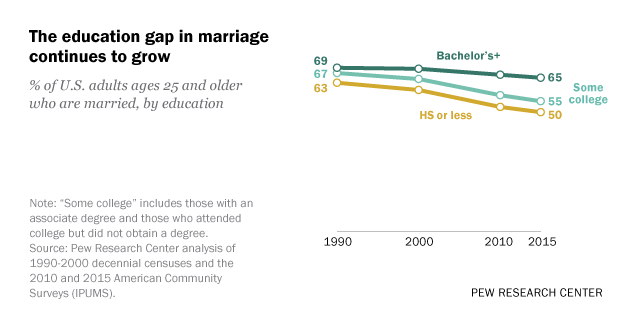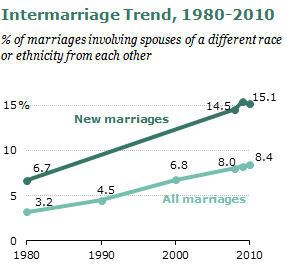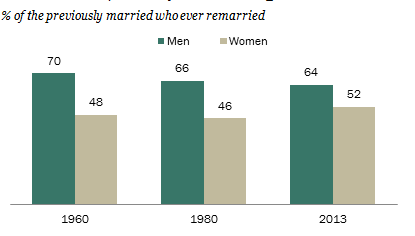Introduction
For many years, Americans have believed that marriages are good since they empower people, make it easier for them to pursue their common goals, and promote the integrity of the community or society. Unfortunately, there are specific developments that have been recorded with the past six decades in this country. Firstly, marriage is no longer a priority for many people who are aged 25 years and below. Secondly, intermarriages have become common in this society than ever before. Thirdly, many people from the same sex or gender are entering into the institution of marriage without the desire or need to have children. Fourthly, people are filing for divorce and starting new relationships that end up in second or third marriages.
This means that the permanence and stability of marriages is no longer a major concern for many citizens. The outstanding fact is that marriage norms in contemporary America have changed significantly since 1960. The purpose of this paper is to present accurate and timely data to describe such four marriage trends recorded in this country.
Marriage Changes and Norms in America
The first notable change in the institution of marriage is that many young people are no longer treating the issue seriously. Instead, they are currently focusing on their passions in life and educational aims. For instance, a study by the Pew Research Center indicated that marriage rates among Americans in their 20s had decreased since the year 1990 (Parker & Stepler, 2017). This trend was observed in individuals with college degrees and certificates. However, the decline was high in persons who did not have advanced university education. In 2008, it was reported that the percentage of 30-year olds in marriage had declined to 62 from 69 in 1990 (Parker & Stepler, 2017).
Similarly, those who do have college degrees are presently delaying their marriages to the age of 28 or more (Parker & Stepler, 2017). The major explanations behind this shift include the declining economic gains and fortunes of young people. Individuals who lack quality education will be reluctant to marry in this country (see Figure 1). The chart reveals that those attain higher education have increased chances of getting additional sources of income, thereby being able to get married.

The second norm that has become prevalent in this country is that of intermarriages. For many years, many Americans have appreciated the lessons gained from slavery and racial discrimination. These malpractices continued to inform marriage patterns whereby people were keen to select partners from their respective racial groups for many decades. However, this trend has changed significantly since many citizens today are marrying from other races. For instance, a report by Pew Research Center in 2010 revealed that 15 percent of marriages were of spouses with diverse backgrounds (“The rise of intermarriage,” 2012).
This rate had increased from 6.7 percent in 1980 (see Figure 2). Additionally, 26 % and 28 percent of Hispanics and Asians respectively are married to other racial grounds (“The rise of intermarriage,” 2012). According to the presented chart, this trend is expected to continue since people are interacting more than ever before. This development is supported by most of the social cohesion and diversity promotion strategies that have become common in this country (“The rise of intermarriage,” 2012). In terms of earnings, males from specific races tend to have higher income rates in comparison with those from minority groups. This difference has remained a critical determinant of marriages whereby women from poor backgrounds marry white men or those with stable income sources.

The American definitions of marriage and family have changed significantly within the past five decades. For instance, 86 percent of Americans believe that a person who has a child can constitute or from a family without having a partner (“The decline of marriage,” 2010). Around 80 percent argue that two people who are cohabiting without even being married constitute a family (“The decline of marriage,” 2010).
Similarly, the practice of same-same marriage has become common than ever before. Within the past two decades, the support for same-sex marriage has increased significantly. In a study completed in 2019, around 61 percent of Americans were in favour of it (“Attitudes on same-sex,” 2019). Those who opposed the practice were around 31 percent (“Attitudes on same-sex,” 2019). This trend is expected to continue redefining the nature of marriage in contemporary America.

The number of male-male couples has increased significantly to over 110,000 in the United States (see Figure 3). This is also the same case for lesbians living as couples at over 139,000 (see Figure 3). Although these numbers represent a small percentage or fraction of the entire population, the outstanding observation is that the contemporary or traditional different-sex marriages are no longer the predominant trend or practice in this country. Experts in the fields of human psychology and sociology still believe that the number of gay and lesbian marriages will continue to increase in the coming years (Cherlin, 2018). This will become a trend that government policymakers should never ignore.
The fourth trend that has been recorded in different parts across the United States revolves around the integrity and sustainability of marriage. For many years, this institution attracted attention of the greatest number community members and citizens. Marriage was seen as something righteous and a gift from God that required care and support from relatives and religious leaders. However, new changes have emerged whereby divorces have become common in the United States. Many married people reasons separate if they are unable to realize their potential (Cherlin, 2018). Majority of these divorcees eventually start new families or relationships that resonate with their expectations. Those who are unable to get good partners decide to live independently or even as single parents.

In a study conducted by the Pew Research Center, it was reported that the gap between the percentage of women and men who remarried after divorce was narrowing (see Figure 4). For instance, only 48 percent of women remarried after divorce in the 1960s (see figure 4). This rate had increased to 52 percent in the year 2013 (see Figure 4). This means that more people are remarrying in this country.
This trend supports the fact that many couples will have specific objectives and goals that must be met by their partners. Similarly, the triggers of this new norm have changed significantly within the past few decades. For example, Livingston (2014) identifies income and life expectations as one of the factors associated with divorce in this country. Others include insecurity, abuse, and pressure from peers or family members. Nonetheless, it is expected that more divorcees will not shy away from establishing new relationships and eventually getting married.
Conclusion
The above charts and discussions have revealed that marriage in contemporary America has changed significantly from the 1960s. The sociological perspective is a powerful model that can explain why these developments have taken place. People’s social backgrounds have continued to influence their views, life chances, and behaviors. For instance, the conflict perspective has dictated people’s decisions and thoughts regarding the issue of marriage. This means that many citizens have been keen to intermarry as one of the best procedures for decreasing the current level of discrimination recorded in this country.
The functionalist aspect of this model goes further to explain why and how people consider different ideas and practices that resonate with their demands. This argument explains why more young adults are delaying their marriage decisions in the United States. The same concept applies when focusing on the increasing number of same-sex marriages in this country and across the world. With these normative changes in place, the American society has been impacted negatively. This is the case since the institution of marriage is no longer respectable. The end result is that more people are leading troubled and disoriented lives while at the same time focusing on the infamous American dream.
The number of children who are unable to get maximum attention from both parents is on the rise. The absence of appropriate role models leaves them disoriented and incapable of pursuing their aims in life diligently (Gravningen et al., 2017). Another impact is that more people prefer divorcing instead of implementing evidence-based measures to save their marriages. These issues and developments will, therefore, continue to affect the integrity of this institution and even make it impossible for more citizens to succeed in their lives.
References
Attitudes on same-sex marriage. (2019). Pew Research Center. Web.
Balk, G. (2018). Seattle area ranks third in nation for same-sex marriages, IRS data show. The Seattle Times. Web.
Cherlin, A. (2018). Marriage has become a hobby. The Atlantic. Web.
The decline of marriage and rise of new families. (2010). Pew Research Center. Web.
Gravningen, K., Mitchell, K. R., Wellings, K., Johnson, A. M., Geary, R., Jones, K. G., … Mercer, C. H. (2017). Reported reasons for breakdown of marriage and cohabitation in Britain: Findings from the third National Survey of Sexual Attitudes and Lifestyles (Natsal-3). PLoS ONE, 12(3), e0174129. Web.
Intermarriage on the rise in the U.S. (2013). Pew Research Center. Web.
Livingston, G. (2014). Chapter 2: The demographics of remarriage. Pew Research Center. Web.
Parker, K., & Stepler, R. (2017). As U.S. marriage rate hovers at 50%, educational gap in marital status widens. Pew Research Center. Web.
The rise of intermarriage. (2012). Pew Research Center. Web.